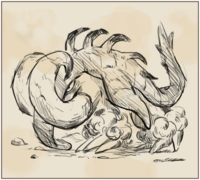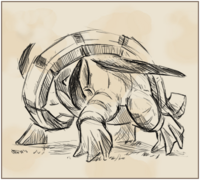Paradox Pokémon: Difference between revisions
(→Pokémon Horizons: The Series: Rewording it and putting references in order.) |
|||
| (21 intermediate revisions by 8 users not shown) | |||
| Line 1: | Line 1: | ||
{{spoilers}} | {{spoilers}} | ||
[[File:Ancient Pokémon promotional artwork.jpg | [[File:Ancient Pokémon promotional artwork.jpg|thumb|450px|{{PTCG}} promotional artwork of ancient Paradox Pokémon]] | ||
[[File:Future Pokémon promotional artwork.jpg | [[File:Future Pokémon promotional artwork.jpg|thumb|450px|{{PTCG}} promotional artwork of future Paradox Pokémon]] | ||
'''Paradox Pokémon''' (Japanese: '''パラドックスポケモン''' ''Paradox Pokémon'') are a group of {{OBP|Pokémon|species}} introduced in {{g|Scarlet and Violet}}. They have two subgroups: one appearing in Pokémon Scarlet resembling ancient relatives of contemporary Pokémon, and one appearing in Pokémon Violet resembling futuristic relatives of contemporary Pokémon. They are all [[gender unknown]] and unable to [[Evolution|evolve]] or [[Pokémon breeding|breed]], and — with the exceptions of {{p|Koraidon}} and {{p|Miraidon}} — their names do not follow | '''Paradox Pokémon''' (Japanese: '''パラドックスポケモン''' ''Paradox Pokémon'') are a group of {{OBP|Pokémon|species}} introduced in {{g|Scarlet and Violet}}. They have two subgroups: one appearing in Pokémon Scarlet resembling ancient relatives of contemporary Pokémon, and one appearing in Pokémon Violet resembling futuristic relatives of contemporary Pokémon. They are all [[gender unknown]] and unable to [[Evolution|evolve]] or [[Pokémon breeding|breed]], and — with the exceptions of {{p|Koraidon}} and {{p|Miraidon}} — their names do not follow typical Pokémon naming conventions. All of them [[List of categories by abundance|share the category]] of "{{pkmn|category|Paradox Pokémon}}". | ||
They are also known as '''unidentified creatures''',<ref>https://scarletviolet.pokemon.com/en-us/news/books/ </ref> '''Monsters of Area Zero'''<ref>[[Scarlet Book]] and [[Violet Book]]</ref> (Japanese: '''エリアゼロの{{ruby|怪物|かいぶつ}}''' ''Monsters of Area Zero''), and '''Enigmas of Paldea'''<ref>https://bulbapedia.bulbagarden.net/wiki/Magazines_in_the_Pokémon_world#Occulture</ref> (Japanese: '''パルデア{{ruby|未確認|みかくにん}}''') by researchers and {{DL|Magazines in the Pokémon world|Occulture}} magazine articles, respectively. [[Professor Sada]]{{sup/9|S}}/[[Professor Turo]]{{sup/9|V}} | They are also known as '''unidentified creatures''',<ref>https://scarletviolet.pokemon.com/en-us/news/books/ </ref> '''Monsters of Area Zero'''<ref>[[Scarlet Book]] and [[Violet Book]]</ref> (Japanese: '''エリアゼロの{{ruby|怪物|かいぶつ}}''' ''Monsters of Area Zero''), and '''Enigmas of Paldea'''<ref>https://bulbapedia.bulbagarden.net/wiki/Magazines_in_the_Pokémon_world#Occulture</ref> (Japanese: '''パルデア{{ruby|未確認|みかくにん}}''') by researchers and {{DL|Magazines in the Pokémon world|Occulture}} magazine articles, respectively. [[Professor Sada]]{{sup/9|S}}/[[Professor Turo]]{{sup/9|V}} researches Paradox Pokémon. The professor also refers to the Paradox Pokémon as '''ancient Pokémon'''{{sup/9|S}}/'''future Pokémon'''{{sup/9|V}}. | ||
The precise origin of the Paradox Pokémon is unclear; AI Sada{{sup/9|S}}/AI Turo{{sup/9|V}} claims that they originate from different points in the [[Pokémon world]]'s timeline<ref>[[Professor Sada|AI Sada]]{{sup/9|S}}/[[Professor Turo|AI Turo]]{{sup/9|V}}: ''"Through analysis of its genetic makeup, as well as its behavioral patterns...I came to realize that what I had discovered was in fact an ancient/futuristic form of {{p|Cyclizar}}, the Pokémon commonly ridden in this region."'' ({{g|Scarlet and Violet}})</ref> (specifically the ancient past{{sup/9|S}}/distant future{{sup/9|V}}), while a version of Sada{{sup/9|S}}/Turo{{sup/9|V}} brought to the [[Crystal Pool]] by {{p|Terapagos}} suggests that they are from [[Pokémon multiverse|different timelines]].<ref>[[Professor Sada]]{{sup/9|S}}/[[Professor Turo]]{{sup/9|V}}: ''"I am researching methods to catch Pokémon that live in different timelines, so I might transport them to the present day in my own timeline."'' ({{g|Scarlet and Violet}}: [[The Indigo Disk]])</ref> The latter notion is also alluded to in the original Japanese version of AI Sada{{sup/9|S}}/AI Turo{{sup/9|V}}'s dialogue.<ref>[[Professor Sada]]{{sup/9|S}}/[[Professor Turo]]{{sup/9|V}}: ''"(てんそう) モンスターボールを転送し (つか) (こと) (じかんじく) 異なる時間軸のポケモンを 捕まえて (げんだい) (よ) 現代へと 呼びだすことができる"'' ({{g|Scarlet and Violet}})</ref> They were apparently brought to [[Area Zero]] in the present day by the [[time machine]] built by the professor, but the [[Scarlet Book]]{{sup/9|S}}/[[Violet Book]]{{sup/9|V}} documents sightings of them prior to the time machine being built. Terapagos appears to have a connection to the Paradox Pokémon's appearance in the present day due to the [[Terastal energy]] it produces. | |||
{{ | |||
==List of Paradox Pokémon== | ==List of Paradox Pokémon== | ||
| Line 13: | Line 12: | ||
====Ancient Pokémon==== | ====Ancient Pokémon==== | ||
These Pokémon look like ancient relatives of contemporary Pokémon. They all share the {{a|Protosynthesis}} [[Ability]], with the exception of {{p|Koraidon}}, which has {{a|Orichalcum Pulse}}. Their Abilities involve the effect of [[harsh sunlight]] in battle. All ancient Pokémon share a unique whistle-like sound frequency in their cries. | These Pokémon look like ancient relatives of contemporary Pokémon. They all share the {{a|Protosynthesis}} [[Ability]], with the exception of {{p|Koraidon}}, which has {{a|Orichalcum Pulse}}. Their Abilities involve the effect of [[harsh sunlight]] in battle. All ancient Pokémon share a unique whistle-like sound frequency in their [[cry|cries]]. | ||
{| class="roundy" align=center style="text-align:center; border:3px solid #{{scarlet color dark}}; background:#{{scarlet color}}" cellpadding=5px | {| class="roundy" align=center style="text-align:center; border:3px solid #{{scarlet color dark}}; background:#{{scarlet color}}" cellpadding=5px | ||
| Line 90: | Line 89: | ||
|- style="background:#FFF" | |- style="background:#FFF" | ||
| style="font-family:monospace,monospace" |#1007 | | style="font-family:monospace,monospace" |#1007 | ||
| [[File:1007Koraidon.png|100px|alt=The Paradox Pokémon Koraidon|link=Koraidon (Pokémon)]]<br>{{p|Koraidon}}<br> | | [[File:1007Koraidon.png|100px|alt=The Paradox Pokémon Koraidon|link=Koraidon (Pokémon)]]<br>{{p|Koraidon}}<br>"Winged King" | ||
| {{typecolor|Fighting}}{{typecolor|Dragon}} | | {{typecolor|Fighting}}{{typecolor|Dragon}} | ||
| style="text-align: left" | '''Pokédex entries: Apex Build''' | | style="text-align: left" | '''Pokédex entries: Apex Build''' | ||
| Line 104: | Line 103: | ||
| [[File:1009Walking Wake.png|100px|alt=The Paradox Pokémon Walking Wake|link=Walking Wake (Pokémon)]]<br>{{p|Walking Wake}} | | [[File:1009Walking Wake.png|100px|alt=The Paradox Pokémon Walking Wake|link=Walking Wake (Pokémon)]]<br>{{p|Walking Wake}} | ||
| {{typecolor|Water}}{{typecolor|Dragon}} | | {{typecolor|Water}}{{typecolor|Dragon}} | ||
| style="text-align: left" | | style="text-align: left" | '''Pokédex entries''' | ||
* | *This ferocious creature is shrouded in mystery. It's named after an aquatic monster mentioned in an old expedition journal. | ||
*It resembles an illustration published in a paranormal magazine, said to be a depiction of a super-ancient Suicune. | |||
| [[File:0245Suicune.png|100px|link=Suicune (Pokémon)]]<br>{{p|Suicune}} | | [[File:0245Suicune.png|100px|link=Suicune (Pokémon)]]<br>{{p|Suicune}} | ||
| {{typecolor|Water}} | | {{typecolor|Water}} | ||
| Line 112: | Line 112: | ||
| [[File:1020Gouging Fire.png|100px|alt=The Paradox Pokémon Gouging Fire|link=Gouging Fire (Pokémon)]]<br>{{p|Gouging Fire}} | | [[File:1020Gouging Fire.png|100px|alt=The Paradox Pokémon Gouging Fire|link=Gouging Fire (Pokémon)]]<br>{{p|Gouging Fire}} | ||
| {{typecolor|Fire}}{{typecolor|Dragon}} | | {{typecolor|Fire}}{{typecolor|Dragon}} | ||
| style="text-align: left" | '''Pokédex entries''' | |||
*There are scant few reports of this creature being sighted. One short video shows it rampaging and spouting pillars of flame. | |||
*It resembles an eerie Pokémon once shown in a paranormal magazine. That Pokémon was said to be an Entei regenerated from a fossil. | |||
| [[File:0244Entei.png|100px|link=Entei (Pokémon)]]<br>{{p|Entei}} | | [[File:0244Entei.png|100px|link=Entei (Pokémon)]]<br>{{p|Entei}} | ||
| {{typecolor|Fire}} | | {{typecolor|Fire}} | ||
| Line 118: | Line 121: | ||
| [[File:1021Raging Bolt.png|100px|alt=The Paradox Pokémon Raging Bolt|link=Raging Bolt (Pokémon)]]<br>{{p|Raging Bolt}} | | [[File:1021Raging Bolt.png|100px|alt=The Paradox Pokémon Raging Bolt|link=Raging Bolt (Pokémon)]]<br>{{p|Raging Bolt}} | ||
| {{typecolor|Electric}}{{typecolor|Dragon}} | | {{typecolor|Electric}}{{typecolor|Dragon}} | ||
| style="text-align: left" | '''Pokédex entries''' | |||
*It's said to incinerate everything around it with lightning launched from its fur. Very little is known about this creature. | |||
*It bears resemblance to a Pokémon that became a hot topic for a short while after a paranormal magazine touted it as Raikou's ancestor. | |||
| [[File:0243Raikou.png|100px|link=Raikou (Pokémon)]]<br>{{p|Raikou}} | | [[File:0243Raikou.png|100px|link=Raikou (Pokémon)]]<br>{{p|Raikou}} | ||
| {{typecolor|Electric}} | | {{typecolor|Electric}} | ||
| Line 125: | Line 131: | ||
====Future Pokémon==== | ====Future Pokémon==== | ||
These Pokémon look like futuristic relatives of contemporary Pokémon. They all share the {{a|Quark Drive}} [[Ability]], with the exception of {{p|Miraidon}}, which has {{a|Hadron Engine}}. Their Abilities involve the effect of {{m|Electric Terrain}} in battle. All future Pokémon cries share a unique electronic, mechanical noise. Their names all contain the word "iron" (or the equivalent in other languages) as a prefix, with the exception of Miraidon—it, however, | These Pokémon look like futuristic relatives of contemporary Pokémon. They all share the {{a|Quark Drive}} [[Ability]], with the exception of {{p|Miraidon}}, which has {{a|Hadron Engine}}. Their Abilities involve the effect of {{m|Electric Terrain}} in battle. All future Pokémon cries share a unique electronic, mechanical noise. Their names all contain the word "iron" (or the equivalent in other languages) as a prefix, with the exception of Miraidon—it, however, is also known as "Iron Serpent". | ||
{| class="roundy" align=center style="text-align:center; border:3px solid #{{violet color dark}}; background:#{{violet color}}" cellpadding=5px | {| class="roundy" align=center style="text-align:center; border:3px solid #{{violet color dark}}; background:#{{violet color}}" cellpadding=5px | ||
| Line 205: | Line 211: | ||
|- style="background:#FFF" | |- style="background:#FFF" | ||
| style="font-family:monospace,monospace" |#1008 | | style="font-family:monospace,monospace" |#1008 | ||
| [[File:1008Miraidon.png|100px|alt=The Paradox Pokémon Miraidon|link=Miraidon (Pokémon)]]<br>{{p|Miraidon}}<br> | | [[File:1008Miraidon.png|100px|alt=The Paradox Pokémon Miraidon|link=Miraidon (Pokémon)]]<br>{{p|Miraidon}}<br>"Iron Serpent" | ||
| {{typecolor|Electric}}{{typecolor|Dragon}} | | {{typecolor|Electric}}{{typecolor|Dragon}} | ||
| style="text-align: left" | '''Pokédex entries: Ultimate Mode''' | | style="text-align: left" | '''Pokédex entries: Ultimate Mode''' | ||
| Line 219: | Line 225: | ||
| [[File:1010Iron Leaves.png|100px|alt=The Paradox Pokémon Iron Leaves|link=Iron Leaves (Pokémon)]]<br>{{p|Iron Leaves}} | | [[File:1010Iron Leaves.png|100px|alt=The Paradox Pokémon Iron Leaves|link=Iron Leaves (Pokémon)]]<br>{{p|Iron Leaves}} | ||
| {{typecolor|Grass}}{{typecolor|Psychic}} | | {{typecolor|Grass}}{{typecolor|Psychic}} | ||
| style="text-align: left" | | style="text-align: left" | '''Pokédex entries''' | ||
* | *Many of its physical characteristics match those of a Virizion from the future that was covered in a paranormal magazine. | ||
*According to the few eyewitness accounts that exist, it used its shining blades to julienne large trees and boulders. | |||
| [[File:0640Virizion.png|100px|link=Virizion (Pokémon)]]<br>{{p|Virizion}} | | [[File:0640Virizion.png|100px|link=Virizion (Pokémon)]]<br>{{p|Virizion}} | ||
| {{typecolor|Grass}}{{typecolor|Fighting}} | | {{typecolor|Grass}}{{typecolor|Fighting}} | ||
| Line 227: | Line 234: | ||
| [[File:1022Iron Boulder.png|100px|alt=The Paradox Pokémon Iron Boulder|link=Iron Boulder (Pokémon)]]<br>{{p|Iron Boulder}} | | [[File:1022Iron Boulder.png|100px|alt=The Paradox Pokémon Iron Boulder|link=Iron Boulder (Pokémon)]]<br>{{p|Iron Boulder}} | ||
| {{typecolor|Rock}}{{typecolor|Psychic}} | | {{typecolor|Rock}}{{typecolor|Psychic}} | ||
| style="text-align: left" | '''Pokédex entries''' | |||
*It resembles a Pokémon described in a dubious magazine as a Terrakion that had been modified by an evil organization. | |||
*It was named after a mysterious object recorded in an old book. Its body seems to be metallic. | |||
| [[File:0639Terrakion.png|100px|link=Terrakion (Pokémon)]]<br>{{p|Terrakion}} | | [[File:0639Terrakion.png|100px|link=Terrakion (Pokémon)]]<br>{{p|Terrakion}} | ||
| {{typecolor|Rock}}{{typecolor|Fighting}} | | {{typecolor|Rock}}{{typecolor|Fighting}} | ||
| Line 233: | Line 243: | ||
| [[File:1023Iron Crown.png|100px|alt=The Paradox Pokémon Iron Crown|link=Iron Crown (Pokémon)]]<br>{{p|Iron Crown}} | | [[File:1023Iron Crown.png|100px|alt=The Paradox Pokémon Iron Crown|link=Iron Crown (Pokémon)]]<br>{{p|Iron Crown}} | ||
| {{typecolor|Steel}}{{typecolor|Psychic}} | | {{typecolor|Steel}}{{typecolor|Psychic}} | ||
| style="text-align: left" | '''Pokédex entries''' | |||
*It resembles a mysterious object introduced in a paranormal magazine as a cutting-edge weapon shaped like a Cobalion. | |||
*There was supposedly an incident in which it launched shining blades to cut everything around it to pieces. Little else is known about it. | |||
| [[File:0638Cobalion.png|100px|link=Cobalion (Pokémon)]]<br>{{p|Cobalion}} | | [[File:0638Cobalion.png|100px|link=Cobalion (Pokémon)]]<br>{{p|Cobalion}} | ||
| {{typecolor|Steel}}{{typecolor|Fighting}} | | {{typecolor|Steel}}{{typecolor|Fighting}} | ||
| Line 309: | Line 322: | ||
{{quartetstats|violet|0967|Cyclizar|normal|70|95|65|85|65|121|0640|Virizion|grass|91|90|72|90|129|108|0639|Terrakion|rock|91|129|90|72|90|108|0638|Cobalion|steel|91|90|129|90|72|108}} | {{quartetstats|violet|0967|Cyclizar|normal|70|95|65|85|65|121|0640|Virizion|grass|91|90|72|90|129|108|0639|Terrakion|rock|91|129|90|72|90|108|0638|Cobalion|steel|91|90|129|90|72|108}} | ||
</div></div></div> | </div></div></div> | ||
==In the spin-off games== | |||
===Pokémon Masters EX=== | |||
The following [[sync pair]]s use Paradox Pokémon: | |||
{{PairDex/h|Violet|Scarlet}} | |||
{{PairDex|173|Nemona|trainerlink=Nemona (Masters)#Scream Tail|trainerimg=Nemona Sygna|sygna=[[Sygna suit|Sygna Suit]]|0985|Scream Tail|master=yes|buddy=yes|Fairy|Poison|Physical Strike|exrole=Sprint|6|Master Fair Sync Pair Scout}} | |||
|} | |||
==In the anime== | ==In the anime== | ||
| Line 314: | Line 335: | ||
[[File:Koraidon anime.png|thumb|left|250px|Koraidon in the {{pkmn|anime}}]] | [[File:Koraidon anime.png|thumb|left|250px|Koraidon in the {{pkmn|anime}}]] | ||
[[File:Miraidon anime.png|thumb|250px|Miraidon in the anime]] | [[File:Miraidon anime.png|thumb|250px|Miraidon in the anime]] | ||
====[[Pokémon Journeys: The Series]]==== | ====''[[Pokémon Journeys: The Series]]''==== | ||
A {{p|Koraidon}} debuted in the [[Team Rocket Expedition which stands by the evils of love and truth|post-episode segment]] of [[JN137]], where {{TRT}} | A {{p|Koraidon}} debuted in the [[Team Rocket Expedition which stands by the evils of love and truth|post-episode segment]] of [[JN137]], where {{TRT}} tried to catch it but failed, resulting in them getting rammed by Koraidon and sent blasting off. | ||
A {{p|Miraidon}} debuted in the post-episode segment of [[JN138]], where Team Rocket | A {{p|Miraidon}} debuted in the post-episode segment of [[JN138]], where Team Rocket tried to catch it as well, but failed, resulting in them getting shocked and sent blasting off. | ||
====[[Pokémon Horizons: The Series]]==== | ====''[[Pokémon Horizons: The Series]]''==== | ||
Paradox Pokémon were referenced in [[HZ056]]. After [[Dot]] asked "[[Chalce|Agepan]]" if she is a fan of the {{DL|Magazines in the Pokémon world|Occulture}} magazine, the undercover [[Explorers|Explorer]] mentioned a resurrected prehistoric {{p|Volcarona}} ({{p|Slither Wing}}) and a {{p|Jigglypuff}} from a billion years ago ({{p|Scream Tail}}), both creatures featured in the Occulture, though she found the ideas presented in the magazine absurd. | |||
===[[Biri-Biri]]=== | ===[[Biri-Biri]]=== | ||
| Line 329: | Line 350: | ||
[[File:Violet Adventures.png|thumb|left|230px|Miraidon in [[Pokémon Adventures]]]] | [[File:Violet Adventures.png|thumb|left|230px|Miraidon in [[Pokémon Adventures]]]] | ||
[[File:Paradox Donphan Adventures.png|thumb|280px|An Iron Treads and a Great Tusk in Pokémon Adventures]] | [[File:Paradox Donphan Adventures.png|thumb|280px|An Iron Treads and a Great Tusk in Pokémon Adventures]] | ||
=== | ===Pokémon Adventures=== | ||
===={{MangaArc|Scarlet & Violet}}==== | ===={{MangaArc|Scarlet & Violet}}==== | ||
{{ga|Miraidon}} debuted as {{adv|Violet}}'s ride Pokémon. He later revealed to [[Arven]] that he had encountered it on a beach at [[Poco Path]], after which [[Professor Turo]] had contracted him and asked him to take care of it. | {{ga|Miraidon}} debuted as {{adv|Violet}}'s ride Pokémon. He later revealed to [[Arven]] that he had encountered it on a beach at [[Poco Path]], after which [[Professor Turo]] had contracted him and asked him to take care of it. | ||
| Line 348: | Line 369: | ||
==Trivia== | ==Trivia== | ||
* The [[Shiny]] colorations of the ancient Paradox Pokémon are based on the Shiny colorations of the Pokémon they are based on. In contrast, every future Paradox Pokémon has a metallic grey Shiny colloration, possibly to reflect their robotic appearances and natures. The only exceptions to these are {{p|Koraidon}} and {{p|Miraidon}}. | * The [[Shiny]] colorations of the ancient Paradox Pokémon are based on the Shiny colorations of the Pokémon they are based on. In contrast, every future Paradox Pokémon has a metallic grey Shiny colloration, possibly to reflect their robotic appearances and natures. The only exceptions to these are {{p|Koraidon}} and {{p|Miraidon}}. | ||
* These Pokémon are similar to the [[ecologically similar Pokémon]] in that they bear a striking resemblance to certain Pokémon but are nonetheless completely different species. | |||
* {{p|Donphan}}, {{p|Volcarona}}, and {{p|Cyclizar}} are the only Pokémon to have both ancient and future Paradox Pokémon counterparts. | * {{p|Donphan}}, {{p|Volcarona}}, and {{p|Cyclizar}} are the only Pokémon to have both ancient and future Paradox Pokémon counterparts. | ||
** All three of these Pokémon have {{type|Fighting}} ancient counterparts. | ** All three of these Pokémon have {{type|Fighting}} ancient counterparts. | ||
* Volcarona is the only Pokémon with Paradox Pokémon relatives that can be naturally found in the same area as them. | |||
* {{p|Iron Valiant}} is the only Paradox Pokémon to be based on more than one Pokémon. | * {{p|Iron Valiant}} is the only Paradox Pokémon to be based on more than one Pokémon. | ||
* {{p|Roaring Moon}}, {{p|Iron Jugulis}}, and {{p|Iron Thorns}} are the only Paradox Pokémon to have a lower [[Base stats|base stat]] total than their contemporary counterparts (all of which are [[pseudo-legendary Pokémon]]). | * {{p|Roaring Moon}}, {{p|Iron Jugulis}}, and {{p|Iron Thorns}} are the only Paradox Pokémon to have a lower [[Base stats|base stat]] total than their contemporary counterparts (all of which are [[pseudo-legendary Pokémon]]). | ||
| Line 376: | Line 399: | ||
** Both groups consist entirely of gender unknown Pokémon in the No Eggs Discovered Egg Group, thus being unable to breed. | ** Both groups consist entirely of gender unknown Pokémon in the No Eggs Discovered Egg Group, thus being unable to breed. | ||
** Both are connected to the [[Game mascot|mascot]] Legendary Pokémon of the games they were introduced in. | ** Both are connected to the [[Game mascot|mascot]] Legendary Pokémon of the games they were introduced in. | ||
** Both have base stats themed around a certain type of number, with the ancient Pokémon having odd-numbered base stats and | ** Both have base stats themed around a certain type of number, with the ancient Pokémon having odd-numbered base stats and the future Pokémon having even-numbered base stats, while Ultra Beasts have base stats themed around prime numbers. Additionally, the levels they learn moves at are themed around numbers, with Paradox Pokémon learning moves around multiples of seven, while Ultra Beasts learn moves around prime numbers. | ||
** The majority of Pokémon in both groups have a base stat total of 570. | ** The majority of Pokémon in both groups have a base stat total of 570. | ||
** Every Ultra Beast and Paradox Pokémon (except {{p|Koraidon}} and {{p|Miraidon}}) has an Ability that boosts its most proficient non-{{stat|HP}} stat. | ** Every Ultra Beast and Paradox Pokémon (except {{p|Koraidon}} and {{p|Miraidon}}) has an Ability that boosts its most proficient non-{{stat|HP}} stat. | ||
Latest revision as of 16:55, 10 September 2024


Paradox Pokémon (Japanese: パラドックスポケモン Paradox Pokémon) are a group of Pokémon introduced in Pokémon Scarlet and Violet. They have two subgroups: one appearing in Pokémon Scarlet resembling ancient relatives of contemporary Pokémon, and one appearing in Pokémon Violet resembling futuristic relatives of contemporary Pokémon. They are all gender unknown and unable to evolve or breed, and — with the exceptions of Koraidon and Miraidon — their names do not follow typical Pokémon naming conventions. All of them share the category of "Paradox Pokémon".
They are also known as unidentified creatures,[1] Monsters of Area Zero[2] (Japanese: エリアゼロの怪物 Monsters of Area Zero), and Enigmas of Paldea[3] (Japanese: パルデア未確認) by researchers and Occulture magazine articles, respectively. Professor SadaS/Professor TuroV researches Paradox Pokémon. The professor also refers to the Paradox Pokémon as ancient PokémonS/future PokémonV.
The precise origin of the Paradox Pokémon is unclear; AI SadaS/AI TuroV claims that they originate from different points in the Pokémon world's timeline[4] (specifically the ancient pastS/distant futureV), while a version of SadaS/TuroV brought to the Crystal Pool by Terapagos suggests that they are from different timelines.[5] The latter notion is also alluded to in the original Japanese version of AI SadaS/AI TuroV's dialogue.[6] They were apparently brought to Area Zero in the present day by the time machine built by the professor, but the Scarlet BookS/Violet BookV documents sightings of them prior to the time machine being built. Terapagos appears to have a connection to the Paradox Pokémon's appearance in the present day due to the Terastal energy it produces.
List of Paradox Pokémon
As a group, Paradox Pokémon share multiple similarities with one another, including a base stat total of either 570, 590, or 670, sharing Abilities related to either harsh sunlight or Electric Terrain, and having two types.
Ancient Pokémon
These Pokémon look like ancient relatives of contemporary Pokémon. They all share the Protosynthesis Ability, with the exception of Koraidon, which has Orichalcum Pulse. Their Abilities involve the effect of harsh sunlight in battle. All ancient Pokémon share a unique whistle-like sound frequency in their cries.
| Pokédex number | Paradox Pokémon | Contemporary relative | ||||||
|---|---|---|---|---|---|---|---|---|
| Image | Type | Description | Image | Type | ||||
| #0984 | 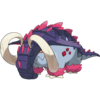 Great Tusk |
Ground Fighting | Great Tusk: A Living Relic of the Dinosaur Era?!
|
 Donphan |
Ground | |||
| #0985 |  Scream Tail |
Fairy Psychic | Scream Tail: A Billion-Year-Old Jigglypuff?!
|
 Jigglypuff |
Normal Fairy | |||
| #0986 | 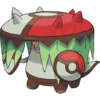 Brute Bonnet |
Grass Dark | Brute Bonnet: Amoonguss Meets Dinosaur?
|
 Amoonguss |
Grass Poison | |||
| #0987 |  Flutter Mane |
Ghost Fairy | Flutter Mane: A Ghostly Pterosaur?!
|
 Misdreavus |
Ghost | |||
| #0988 | 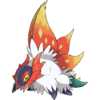 Slither Wing |
Bug Fighting | Slither Wing: A Prehistoric Volcarona, Revived?!
|
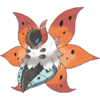 Volcarona |
Bug Fire | |||
| #0989 |  Sandy Shocks |
Electric Ground | Sandy Shocks: A Magneton with a 10-Thousand-Year Lifespan?!
|
 Magneton |
Electric Steel | |||
| #1005 |  Roaring Moon |
Dragon Dark | Roaring Moon: A Primeval Salamence?!
|
 Mega Salamence |
Dragon Flying | |||
| #1007 |  Koraidon "Winged King" |
Fighting Dragon | Pokédex entries: Apex Build
Pokédex entries: Limited Build*
|
 Cyclizar |
Dragon Normal | |||
| #1009 |  Walking Wake |
Water Dragon | Pokédex entries
|
 Suicune |
Water | |||
| #1020 |  Gouging Fire |
Fire Dragon | Pokédex entries
|
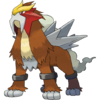 Entei |
Fire | |||
| #1021 | 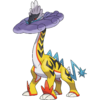 Raging Bolt |
Electric Dragon | Pokédex entries
|
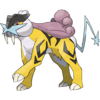 Raikou |
Electric | |||
Future Pokémon
These Pokémon look like futuristic relatives of contemporary Pokémon. They all share the Quark Drive Ability, with the exception of Miraidon, which has Hadron Engine. Their Abilities involve the effect of Electric Terrain in battle. All future Pokémon cries share a unique electronic, mechanical noise. Their names all contain the word "iron" (or the equivalent in other languages) as a prefix, with the exception of Miraidon—it, however, is also known as "Iron Serpent".
| Pokédex number | Paradox Pokémon | Contemporary relative | ||||||
|---|---|---|---|---|---|---|---|---|
| Image | Type | Description | Image | Type | ||||
| #0990 |  Iron Treads |
Ground Steel | Iron Treads: An Alien Weapon?!
|
 Donphan |
Ground | |||
| #0991 |  Iron Bundle |
Ice Water | Iron Bundle: An Ancient Civilization's Robot?!
|
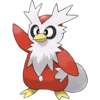 Delibird |
Ice Flying | |||
| #0992 |  Iron Hands |
Fighting Electric | Iron Hands: Secretly a Cyborg?!
|
 Hariyama |
Fighting | |||
| #0993 |  Iron Jugulis |
Dark Flying | Iron Jugulis: Pokémon or Machine?!
|
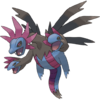 Hydreigon |
Dark Dragon | |||
| #0994 |  Iron Moth |
Fire Poison | Iron Moth: A UFO Sent to Spy on Humankind?!
|
 Volcarona |
Bug Fire | |||
| #0995 |  Iron Thorns |
Rock Electric | Iron Thorns: A Tyranitar of the Distant Future?!
|
 Tyranitar |
Rock Dark | |||
| #1006 |  Iron Valiant |
Fairy Fighting | Iron Valiant: An Experiment Gone Wrong?!
|
 Gardevoir |
Psychic Fairy | |||
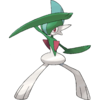 Gallade |
Psychic Fighting | |||||||
| #1008 |  Miraidon "Iron Serpent" |
Electric Dragon | Pokédex entries: Ultimate Mode
Pokédex entries: Low-Power Mode*
|
 Cyclizar |
Dragon Normal | |||
| #1010 | 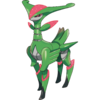 Iron Leaves |
Grass Psychic | Pokédex entries
|
 Virizion |
Grass Fighting | |||
| #1022 |  Iron Boulder |
Rock Psychic | Pokédex entries
|
 Terrakion |
Rock Fighting | |||
| #1023 |  Iron Crown |
Steel Psychic | Pokédex entries
|
 Cobalion |
Steel Fighting | |||
In the core series games
History
Pokémon Scarlet and Violet
It is unknown where the Paradox Pokémon originate from. Conflicting accounts claim that they either come from the ancient pastS/distant futureV, or from different timelines.
Area Zero expedition


The first recorded sightings of Paradox Pokémon were documented 200 years before the events of Pokémon Scarlet and Violet, in Area Zero within the Great Crater of Paldea located in the center of the Paldea region. A member of the Area Zero expedition team, an author and natural historian named Heath, wrote about these sightings in the Scarlet BookS/Violet BookV. Area Zero would be occupied by scientists researching the Paradox Pokémon and the Terastal phenomenon. During the expedition, a member of the team was fatally injured by a Great TuskS/Iron TreadsV that attacked them, and another survey team member managed to take a photograph of the encountered Paradox Pokémon. They at some point also encountered a Winged KingS/Iron SerpentV that was used in Heath's Scarlet BookS/Violet BookV's cover. After encountering each of the known Paradox Pokémon, Heath named each of them in his journal.
At some point, the team's sketch artist made a drawing inspired by the Paradox Pokémon they had seen, imagining what other species in the crater might look like, which resembled a combined version of the Legendary beastsS/Swords of JusticeV. Walking WakeS/Iron LeavesV, Gouging FireS/Iron BoulderV, and Raging BoltS/Iron CrownV would be later discovered, resembling the sketch, but their connection is unclear. It is unclear how these first Paradox Pokémon arrived in Paldea, but they were supposedly brought over by Terapagos due to its Terastal energy. At the time, the Paradox Pokémon were believed to have been fabricated by Heath, thus not being considered real. As a result, Heath and his team were widely discredited. The Paradox Pokémon faded into obscurity and research on them ended for a time. None of these Paradox Pokémon similar to these groups are found in Paldea's Pokédex, but instead, Blueberry Academy's.
Project Tera
10 years before the events of Pokémon Scarlet and Violet, the Paradox Pokémon claimed to be from the ancient pastS/distant futureV were brought to Area Zero using a time machine built by Professor SadaS/Professor TuroV through Terapagos's Terastal energy. The professor is said to have used the time machine to send Poké Balls to different points in the timeline. The Poké Balls then caught the Paradox Pokémon, before bringing them into modern time. The reason the professor created the time machine was because they were fascinated with the Paradox Pokémon after reading about them from the Scarlet BookS/Violet BookV.
The professor conducted research on these Pokémon, with the ultimate goal of establishing a sanctuary in which they would be able to coexist with modern-day Pokémon. This goal would be called Project Tera. At some point, the professor created an AI version of themselves, to assist in research on Paradox Pokémon, using the very same Terastal energy that helped create the time machine. However, due to how dangerous they were to the ecosystem of Paldea, the Paradox Pokémon were kept locked away in Area Zero. At some point, security blocks and a Poké Ball Lock System were created to help both protect the time machine and Paradox Pokémon.
A quirky, friendly KoraidonS/MiraidonV was the first of the Paradox Pokémon to be brought into the present; a second specimen was later brought into the present as well, but it proved to be far more aggressive than the original and drove it away in a territorial dispute. At some point, the professor also renamed the species from Winged KingS/Iron SerpentV to KoraidonS/MiraidonV, taking the name from a child after they found themselves in an unfamiliar place. It is later revealed that the professor was killed by the second specimen while defending the first. Because of this, the Paradox Pokémon would continue to arrive in Area Zero and eventually form their own population in Area Zero. Meanwhile, the professor's AI counterpart realized that the project was a mistake and that their creator's dreams were doomed to failure; however, their programming prevented them from doing anything that might stop the project directly.
Occulture
Later, shortly before the events of Scarlet and Violet, some Paradox Pokémon started to escape Area Zero, so a paranormal magazine called Occulture started publishing articles on recent sightings of them, theorizing about what the Paradox Pokémon could be and mentioning their similarities to the entities mentioned in the Scarlet BookS/Violet BookV. According to the Pokédex entries and the Occulture issues, sightings of all Paradox Pokémon happened all over Paldea, which implies that at least one of each of the Paradox Pokémon managed to escape the crater at some point.
The Quaking Earth Titan
Later, shortly before the events of Scarlet and Violet, a lone Great TuskS/Iron TreadsV escaped Area Zero like others did and become a Titan Pokémon after eating the Herba Mystica while roaming the Asado Desert. During the events of the games, the player and Arven defeat it, putting an end to its rampage, and taking its Herbs, which forces it back to its original size.
The Way Home
During the events of The Way Home in Scarlet and Violet, the player, Arven, Nemona, and Penny encountered several Paradox Pokémon while heading deeper into Area Zero. At Research Station 2, they encountered a wild Scream TailS/Iron BundleV, which Penny mistook for an ordinary JigglypuffS/DelibirdV until it became hostile. At Research Station 3, they encountered a wild Great TuskS/Iron TreadsV, like the one fought in the Asado Desert. Then, outside the Zero Lab, the other KoraidonS/MiraidonV was encountered before the group was ambushed by a group of Paradox Pokémon: Great Tusk, Brute Bonnet, and Flutter ManeS; or Iron Treads, Iron Hands, and Iron JugulisV. The AI professor's Paradox Protection Protocol fights the player using seven Paradox Pokémon in an attempt to defend the time machine. After a long battle, the player and their KoraidonS/MiraidonV successfully defeat the Paradox Protection Protocol and the other KoraidonS/MiraidonV. The time machine that summoned the Paradox Pokémon was then shut down when the AI professor used it one final time to travel to the ancient pastS/distant futureV.
Post-game Paradox Pokémon
Afterward, the rest of the Paradox Pokémon can be found in Area Zero during the post-game, including Roaring MoonS/Iron ValiantV and the second KoraidonS/MiraidonV. Walking WakeS/Iron LeavesV have only appeared in special Poké Portal News event Tera Raid Battles. Great TuskS/Iron TreadsV, Slither WingS/Iron MothV, Iron Bundle, Flutter ManeS/Iron JugulisV, and Sandy ShocksS/Iron ThornsV have also appeared in special Tera Raids.
The Indigo Disk
Later on after helping Perrin find the Bloodmoon Beast in The Teal Mask, she appears in the Blueberry Academy's Terarium, working there as a photographer to get promotional pictures for the academy. After the player catches 200 Pokémon in the Blueberry Pokédex and shows the player two blurry pictures, one of Gouging FireS/Iron BoulderV and one of Raging BoltS/Iron CrownV, however, she's unsure if the creatures caught in these pictures are even real to begin with. After that, the two Paradox Pokémon can be encountered in Area Zero close to where the pictures were taken, surprising Perrin that they were indeed real Pokémon.
During Briar's expedition in Area Zero Underdepths, the player encounters a Stellar Tera Sandy ShocksS/Iron ThornsV that they need to defeat in order to open the way to travel deeper.
| Spoilers end here. |
|---|
Base stats comparison
| Pokémon |  Great Tusk |
 Scream Tail |
 Brute Bonnet |
 Flutter Mane |
 Slither Wing |
 Sandy Shocks |
 Roaring Moon | |||||||
|---|---|---|---|---|---|---|---|---|---|---|---|---|---|---|
| HP |
|
|
|
|
|
|
| |||||||
| Attack |
|
|
|
|
|
|
| |||||||
| Defense |
|
|
|
|
|
|
| |||||||
| Sp. Attack |
|
|
|
|
|
|
| |||||||
| Sp. Defense |
|
|
|
|
|
|
| |||||||
| Speed |
|
|
|
|
|
|
| |||||||
| Total | 570 | 570 | 570 | 570 | 570 | 570 | 590 |
| Pokémon |  Donphan |
 Jigglypuff |
 Amoonguss |
 Misdreavus |
 Volcarona |
 Magneton |
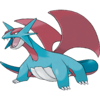 Salamence | |||||||
|---|---|---|---|---|---|---|---|---|---|---|---|---|---|---|
| HP |
|
|
|
|
|
|
| |||||||
| Attack |
|
|
|
|
|
|
| |||||||
| Defense |
|
|
|
|
|
|
| |||||||
| Sp. Attack |
|
|
|
|
|
|
| |||||||
| Sp. Defense |
|
|
|
|
|
|
| |||||||
| Speed |
|
|
|
|
|
|
| |||||||
| Total | 500 | 270 | 464 | 435 | 550 | 465 | 600 |
| Pokémon |  Koraidon |
 Walking Wake |
 Gouging Fire |
 Raging Bolt | ||||
|---|---|---|---|---|---|---|---|---|
| HP |
|
|
|
| ||||
| Attack |
|
|
|
| ||||
| Defense |
|
|
|
| ||||
| Sp. Attack |
|
|
|
| ||||
| Sp. Defense |
|
|
|
| ||||
| Speed |
|
|
|
| ||||
| Total | 670 | 590 | 590 | 590 |
| Pokémon |  Iron Treads |
 Iron Bundle |
 Iron Hands |
 Iron Jugulis |
 Iron Moth |
 Iron Thorns |
 Iron Valiant | |||||||
|---|---|---|---|---|---|---|---|---|---|---|---|---|---|---|
| HP |
|
|
|
|
|
|
| |||||||
| Attack |
|
|
|
|
|
|
| |||||||
| Defense |
|
|
|
|
|
|
| |||||||
| Sp. Attack |
|
|
|
|
|
|
| |||||||
| Sp. Defense |
|
|
|
|
|
|
| |||||||
| Speed |
|
|
|
|
|
|
| |||||||
| Total | 570 | 570 | 570 | 570 | 570 | 570 | 590 |
| Pokémon |  Donphan |
 Delibird |
 Hariyama |
 Hydreigon |
 Volcarona |
 Tyranitar |
 Gardevoir |
 Gallade | ||||||||
|---|---|---|---|---|---|---|---|---|---|---|---|---|---|---|---|---|
| HP |
|
|
|
|
|
|
|
| ||||||||
| Attack |
|
|
|
|
|
|
|
| ||||||||
| Defense |
|
|
|
|
|
|
|
| ||||||||
| Sp. Attack |
|
|
|
|
|
|
|
| ||||||||
| Sp. Defense |
|
|
|
|
|
|
|
| ||||||||
| Speed |
|
|
|
|
|
|
|
| ||||||||
| Total | 500 | 330 | 474 | 600 | 550 | 600 | 518 | 518 |
| Pokémon |  Miraidon |
 Iron Leaves |
 Iron Boulder |
 Iron Crown | ||||
|---|---|---|---|---|---|---|---|---|
| HP |
|
|
|
| ||||
| Attack |
|
|
|
| ||||
| Defense |
|
|
|
| ||||
| Sp. Attack |
|
|
|
| ||||
| Sp. Defense |
|
|
|
| ||||
| Speed |
|
|
|
| ||||
| Total | 670 | 590 | 590 | 590 |
In the spin-off games
Pokémon Masters EX
The following sync pairs use Paradox Pokémon:
| Dex | Trainer | NDex | Pokémon | Type | Weakness | Role | EX role | Base potential | Availability | ||
|---|---|---|---|---|---|---|---|---|---|---|---|
| #173 | Sygna Suit Nemona |
#0985 | Scream Tail |
Fairy |
Poison |
★★★★★☆EX | Master Fair Sync Pair Scout | ||||
In the anime
Main series

Pokémon Journeys: The Series
A Koraidon debuted in the post-episode segment of JN137, where Team Rocket tried to catch it but failed, resulting in them getting rammed by Koraidon and sent blasting off.
A Miraidon debuted in the post-episode segment of JN138, where Team Rocket tried to catch it as well, but failed, resulting in them getting shocked and sent blasting off.
Pokémon Horizons: The Series
Paradox Pokémon were referenced in HZ056. After Dot asked "Agepan" if she is a fan of the Occulture magazine, the undercover Explorer mentioned a resurrected prehistoric Volcarona (Slither Wing) and a Jigglypuff from a billion years ago (Scream Tail), both creatures featured in the Occulture, though she found the ideas presented in the magazine absurd.
Biri-Biri
A Great Tusk, namely the Quaking Earth Titan, briefly appears as a silhouette in the music video for Biri-Biri.
In the manga

Pokémon Adventures
Scarlet & Violet arc
Miraidon debuted as Violet's ride Pokémon. He later revealed to Arven that he had encountered it on a beach at Poco Path, after which Professor Turo had contracted him and asked him to take care of it.
In PASV02, Violet and Arven visited Asado Desert and encountered two Paradox Pokémon; the Quaking Earth Titan Iron Treads and a Great Tusk. Being outmatched against the former, they were ultimately forced to retreat.
In the TCG
- Main articles: Ancient (TCG); Future (TCG)
The Paradox Pokémon Great Tusk, Iron Treads, Koraidon, and Miraidon appear in the Pokémon Trading Card Game starting with the Scarlet & Violet expansion (the Japanese Scarlet ex and Violet ex expansions) as Pokémon ex cards. Non-Pokémon ex versions of Koraidon and Miraidon were also released in the same expansion.
Starting with the Paradox Rift expansion (the Japanese Ancient Roar and Future Flash expansions), two new categories of cards were introduced: Ancient and Future, which includes all cards of Paradox Pokémon released in this set. Ancient Pokémon cards tend to have direct attacks that deal a large amount of damage, while being difficult to Knock Out. Future Pokémon cards tend to have Abilities and attacks with extra effects, allowing for craftier strategies.
Trivia
- The Shiny colorations of the ancient Paradox Pokémon are based on the Shiny colorations of the Pokémon they are based on. In contrast, every future Paradox Pokémon has a metallic grey Shiny colloration, possibly to reflect their robotic appearances and natures. The only exceptions to these are Koraidon and Miraidon.
- These Pokémon are similar to the ecologically similar Pokémon in that they bear a striking resemblance to certain Pokémon but are nonetheless completely different species.
- Donphan, Volcarona, and Cyclizar are the only Pokémon to have both ancient and future Paradox Pokémon counterparts.
- All three of these Pokémon have Fighting-type ancient counterparts.
- Volcarona is the only Pokémon with Paradox Pokémon relatives that can be naturally found in the same area as them.
- Iron Valiant is the only Paradox Pokémon to be based on more than one Pokémon.
- Roaring Moon, Iron Jugulis, and Iron Thorns are the only Paradox Pokémon to have a lower base stat total than their contemporary counterparts (all of which are pseudo-legendary Pokémon).
- The ancient Pokémon, Flutter Mane, Scream Tail and Sandy Shocks are the only Paradox Pokémon whose contemporary relatives are not fully evolved. Furthermore, these contemporary Pokémon all evolve with Evolution stones.
- No Paradox Pokémon based on a version-exclusive Pokémon is available in the same version as its present-day counterpart in Pokémon Scarlet and Violet, except for the post-release Paradox Pokémon based on Legendary trios; for example, both Raikou and Raging Bolt are exclusive to Pokémon Scarlet.
- Of these, Flutter Mane is the only one not based on a pseudo-legendary Pokémon.
- All Paradox Pokémon are dual-type.
- All Paradox Pokémon share one of their types with their apparent relatives and have another type that the relative lacks.
- There is at least one Paradox Pokémon of every type except Normal.
- Dragon is the most common types for Paradox Pokémon to have, with six Paradox Pokémon having it.
- Miraidon and Raging Bolt are the only Paradox Pokémon to share both of their types with each other.
- The naming convention for Paradox Pokémon differs by language:
- In Japanese, Spanish, Italian, and German, along with all East Asian translations, Paradox Pokémon are named with a single word.
- In English, Paradox Pokémon are named with a two-word descriptor; all future Paradox Pokémon have "Iron" as the first word in their names.
- In French, Paradox Pokémon are named with two or three words hyphenated into a single name; all future Paradox Pokémon have the suffix "-de-Fer" in their names.
- All ancient Pokémon are taller than the Pokémon they are based on, while all future Pokémon except Miraidon are shorter.
- Furthermore, all ancient Pokémon weigh more than the Pokémon they are based on except Sandy Shocks, which weighs the same as Magneton.
- Raging Bolt and Gouging Fire are the only ancient Paradox Pokémon that do not have yellow eyes.
- Despite all of the future Paradox Pokémon having “Iron” in their name, only Iron Treads and Iron Crown are actually Steel type.
- In their battle against the player in Pokémon Scarlet and Violet, Professor SadaS/Professor TuroV uses every Paradox Pokémon present in the base game, with the exception of Great TuskS/Iron TreadsV, which is instead fought as a Titan Pokémon earlier in the story.
- Generation II and Generation V are both tied for having the most Paradox Pokémon counterparts of Pokémon that debuted during them, at seven each. Out of the generations that have at least one, Generation IV has the fewest, at one. Generation VI, Generation VII, and Generation VIII all have no Paradox Pokémon counterparts of Pokémon at all (though Roaring Moon is based on Mega Salamence, a form that was introduced in Generation VI).
- The Paradox Pokémon share similarities with the Ultra Beasts, another group of Pokémon.
- Both groups consist only of Pokémon that cannot evolve in the first set of games they appear in.
- Both play a role in the main story of their debut games.
- Both appear to originate from another world.
- Both groups consist entirely of gender unknown Pokémon in the No Eggs Discovered Egg Group, thus being unable to breed.
- Both are connected to the mascot Legendary Pokémon of the games they were introduced in.
- Both have base stats themed around a certain type of number, with the ancient Pokémon having odd-numbered base stats and the future Pokémon having even-numbered base stats, while Ultra Beasts have base stats themed around prime numbers. Additionally, the levels they learn moves at are themed around numbers, with Paradox Pokémon learning moves around multiples of seven, while Ultra Beasts learn moves around prime numbers.
- The majority of Pokémon in both groups have a base stat total of 570.
- Every Ultra Beast and Paradox Pokémon (except Koraidon and Miraidon) has an Ability that boosts its most proficient non-HP stat.
- Promotional material for both groups' debut games did not refer to them as Pokémon or reveal any of their types prior to the games' releases.
- Characters in the games are initially unsure whether the members of either group are actually Pokémon.
- With the exception of Koraidon and Miraidon, both groups have a certain sound sample that recurs in their cries.
- The term "Paradox Pokémon" may be a reference to Animalia Paradoxa or the concept of a temporal paradox.
- The Paradox Pokémon (excluding Koraidon and Miraidon) and Type: Null are the only Pokémon to have Spanish, Italian, Brazilian Portuguese, and Turkish names different to their English names, Russian names that are not orthographic transcriptions of their English names, and Thai names that are not orthographic transcriptions of their Japanese names.
- All Paradox Pokémon's Pokédex entries in the versions they are not obtainable in reference Occulture, except Koraidon and Miraidon, whose entries instead reference them resembling Cyclizar but being more aggressive, as well as little being known about them.
In other languages
Paradox Pokémon
| |||||||||||||||||||||||||||||||||||
Monsters of Area Zero
| ||||||||||||||||||||||||||
Enigmas of Paldea
| ||||||||||||||||||||||||||
Ancient Pokémon
| ||||||||||||||||||||||||||
Future Pokémon
| ||||||||||||||||||||||||||
References
- ↑ https://scarletviolet.pokemon.com/en-us/news/books/
- ↑ Scarlet Book and Violet Book
- ↑ https://bulbapedia.bulbagarden.net/wiki/Magazines_in_the_Pokémon_world#Occulture
- ↑ AI SadaS/AI TuroV: "Through analysis of its genetic makeup, as well as its behavioral patterns...I came to realize that what I had discovered was in fact an ancient/futuristic form of Cyclizar, the Pokémon commonly ridden in this region." (Pokémon Scarlet and Violet)
- ↑ Professor SadaS/Professor TuroV: "I am researching methods to catch Pokémon that live in different timelines, so I might transport them to the present day in my own timeline." (Pokémon Scarlet and Violet: The Indigo Disk)
- ↑ Professor SadaS/Professor TuroV: "(てんそう) モンスターボールを転送し (つか) (こと) (じかんじく) 異なる時間軸のポケモンを 捕まえて (げんだい) (よ) 現代へと 呼びだすことができる" (Pokémon Scarlet and Violet)
See also
- Legendary Pokémon
- Ultra Beast
- Herba Mystica
- Terastal phenomenon
- Scarlet Book
- Violet Book
- Great Crater of Paldea
- Area Zero
- Occulture
- Paradox duo
- Ecologically similar Pokémon
- Time travel
- Time machine
